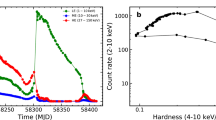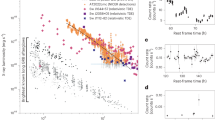Abstract
Black holes undergoing accretion are thought to emit the bulk of their power in the X-ray band by releasing the gravitational potential energy of the infalling matter1. At the same time, they are capable of producing highly collimated jets of energy and particles flowing out of the system with relativistic velocities2. Here we show that the 10-solar-mass (10M⊙) black hole in the X-ray binary Cygnus X-1 (refs 3–5) is surrounded by a large-scale (∼5 pc in diameter) ring-like structure that appears to be inflated by the inner radio jet6. We estimate that in order to sustain the observed emission of the ring, the jet of Cygnus X-1 has to carry a kinetic power that can be as high as the bolometric X-ray luminosity of the binary system. This result may imply that low-luminosity stellar-mass black holes as a whole dissipate the bulk of the liberated accretion power in the form of ‘dark’, radiatively inefficient relativistic outflows, rather than locally in the X-ray-emitting inflow.
This is a preview of subscription content, access via your institution
Access options
Subscribe to this journal
Receive 51 print issues and online access
$199.00 per year
only $3.90 per issue
Buy this article
- Purchase on Springer Link
- Instant access to full article PDF
Prices may be subject to local taxes which are calculated during checkout



Similar content being viewed by others
References
Frank, J., King, A. R. & Raine, D. J. Accretion Power in Astrophysics (Cambridge Univ. Press, Cambridge, 2002)
Hughes, P. A. Beams and Jets in Astrophysics (Cambridge Astrophysics Series, Cambridge Univ. Press, Cambridge, 1991)
Bowyer, S., Byram, E. T., Chubb, T. A. & Friedman, H. Cosmic X-ray sources. Science 147, 394–398 (1965)
Gies, D. R. & Bolton, C. T. The optical spectrum of HDE 226868 = Cygnus X-1. II—Spectrophotometry and mass estimates. Astrophys. J. 304, 371–393 (1986)
Herrero, A., Kudritzki, R. P., Gabler, R., Vilchez, J. M. & Gabler, A. Fundamental parameters of galactic luminous OB stars. II. A spectroscopic analysis of HDE 226868 and the mass of Cygnus X-1. Astron. Astrophys. 297, 556–566 (1995)
Stirling, A. M. et al. A relativistic jet from Cygnus X-1 in the low/hard X-ray state. Mon. Not. R. Astron. Soc. 327, 1273–1278 (2001)
Urry, C. M. & Radovani, P. Unified schemes for radio-loud active galactic nuclei. Publ. Astron. Soc. Pacif. 107, 803–845 (1995)
Blandford, R. D. Black holes and relativistic jets. Prog. Theor. Phys. Suppl. 143, 182–201 (2001)
Mirabel, I. F. & Rodríguez, L. F. A superluminal source in the galaxy. Nature 371, 46–48 (1994)
Mirabel, I. F. & Rodríguez, L. F. Sources of relativistic jets in the galaxy. Annu. Rev. Astron. Astrophys. 37, 409–443 (1999)
Fender, R. P. Jets from X-ray binaries. in Compact Stellar X-Ray Sources (eds Lewin, W. H. G. & van der Klis, M.) (Cambridge Univ. Press, Cambridge, in the press)
Martí, J., Rodríguez, L. F., Mirabel, I. F. & Paredes, J. M. A search for arcminute-scale radio jets in Cygnus X-1. Astron. Astrophys. 306, 449–454 (1996)
Sharpless, S. A Catalogue of HII regions. Astrophys. J. Suppl. Ser. 4, 257–279 (1959)
Hunter, D. A. & Massey, P. Small galactic H II regions. I—Spectral classifications of massive stars. Astron. J. 99, 846–856 (1990)
Lestrade, J.-F. et al. High-precision VLBI astrometry of radio-emitting stars. Astron. Astrophys. 344, 1014–1026 (1999)
Mirabel, I. F. & Rodrigues, I. Formation of a black hole in the dark. Science 300, 1119–1120 (2003)
Smith, D. A., Wilson, A. S., Arnaud, K. A., Terashima, Y. & Young, A. J. A Chandra X-Ray study of Cygnus A. III. The cluster of galaxies. Astrophys. J. 565, 195–207 (2002)
Burbidge, G. R. Estimates of the total energy in particles and magnetic field in the non-thermal radio sources. Astrophys. J. 129, 849–851 (1959)
Castor, J., McCray, R. & Weaver, R. Interstellar bubbles. Astrophys. J. 200, L107–L110 (1975)
Kaiser, C. R. & Alexander, P. A self-similar model for extragalactic radio sources. Mon. Not. R. Astron. Soc. 286, 215–222 (1997)
Heinz, S., Reynolds, C. S. & Begelman, M. C. X-ray signatures of evolving radio galaxies. Astrophys. J. 501, 126–136 (1998)
Longair, M. S. High Energy Astrophysics (Cambridge Univ. Press, Cambridge, 1992)
Lotz, W. Electron-impact ionization cross-sections and ionization rate coefficients for atoms and ions. Astrophys. J. Suppl. Ser. 14, 207–238 (1967)
McClintock, J. E. & Remillard, R. A. Black hole binaries. in Compact Stellar X-Ray Sources (eds Lewin, W. H. G. & van der Klis, M.) (Cambridge Univ. Press, Cambridge, in the press)
Fender, R. P., Pooley, G. G., Durouchoux, P., Tilanus, R. P. J. & Brocksopp, C. The very flat radio-millimetre spectrum of Cygnus X-1. Mon. Not. R. Astron. Soc. 312, 853–858 (2000)
Di Salvo, T., Done, C., Zycki, P. T., Burderi, L. & Robba, N. R. Probing the inner region of Cygnus X-1 in the low/hard state through its X-ray broadband spectrum. Astrophys. J. 547, 1024–1033 (2001)
Gallo, E., Fender, R. P. & Pooley, G. G. A universal radio/X-ray correlation in low/hard state black hole binaries. Mon. Not. R. Astron. Soc. 34, 60–72 (2003)
Livio, M., Pringle, J. E. & King, A. R. The disk-jet connection in microquasars and AGN. Astrophys. J. 593, 184–188 (2003)
Malzac, J., Merloni, A. & Fabian, A. C. Jet-disc coupling through a common energy reservoir in the black hole XTE J1118 + 480. Mon. Not. R. Astron. Soc. 351, 253–264 (2004)
Fender, R. P., Gallo, E. & Jonker, P. G. Jet-dominated states: an alternative to advection across black hole event horizons in ‘quiescent’ X-ray binaries. Mon. Not. R. Astron. Soc. 343, L99–L103 (2003)
Acknowledgements
We thank D. Mislis and R. Corradi for the Hα observation presented in this work. The Westerbork Synthesis Radio Telescope is operated by ASTRON (the Netherlands Foundation for Research in Astronomy) with support from the Netherlands Foundation for Scientific Research (NWO).
Author information
Authors and Affiliations
Corresponding author
Ethics declarations
Competing interests
Reprints and permissions information is available at npg.nature.com/reprintsandpermissions. The authors declare no competing financial interests.
Rights and permissions
About this article
Cite this article
Gallo, E., Fender, R., Kaiser, C. et al. A dark jet dominates the power output of the stellar black hole Cygnus X-1. Nature 436, 819–821 (2005). https://doi.org/10.1038/nature03879
Received:
Accepted:
Issue Date:
DOI: https://doi.org/10.1038/nature03879
This article is cited by
-
Thermonuclear explosions on neutron stars reveal the speed of their jets
Nature (2024)
-
Identifying Galactic sources of high-energy neutrinos
Astrophysics and Space Science (2020)
-
An evolving jet from a strongly magnetized accreting X-ray pulsar
Nature (2018)
-
A galactic microquasar mimicking winged radio galaxies
Nature Communications (2017)
-
Relativistic Jets in Active Galactic Nuclei and Microquasars
Space Science Reviews (2017)
Comments
By submitting a comment you agree to abide by our Terms and Community Guidelines. If you find something abusive or that does not comply with our terms or guidelines please flag it as inappropriate.



